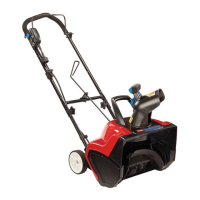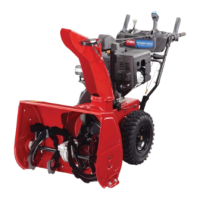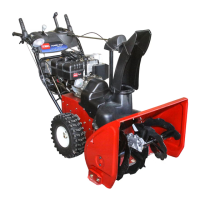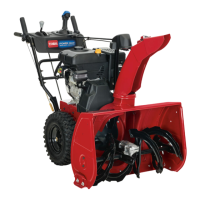9
The deflector handle on top of the dischar
ge chute
controls the height of the snow stream (Fig. 10).
Adjust the height of the snow stream by raising or
lowering the chute deflector
.
1
1516
Figure
10
1. Chute
deflector handle
POTENTIAL
HAZARD
•
A gap between the chute and the chute
deflector will allow snow and anything that may
be picked up by snowthr
ower to fly in the
dir
ection of the operator
.
WHA
T CAN HAPPEN
• Thr
own objects could cause serious personal
injury.
HOW T
O A
V
OID THE HAZARD
•
Do not for
ce the chute deflector too far forward
so that a gap appears between the chute and
chute deflector
.
•
Do not overtighten the deflector mounting nuts
so that you need to use excessive for
ce to adjust
the deflector
.
•
Begin removing snow near the electrical outlet and
work outward. Blow back and forth, not away from
and toward the outlet.
•
When turning at the end of a swath, step over the cord
and turn the snowthrower
.
•
Always overlap each swath and dischar
ge the snow
downwind when possible.
•
Shave down lar
ge banks of snow by placing the
snowthrower on the bank. Lift the snowthrower by the
primary and secondary handles only (Fig. 1
1). Let the
snowthrower’
s weight shave down the bank in a
back-and-forth motion.
1516
2
1
Figure
1
1
1. Primary
handle
2.
Secondary handle
• When
clearing steps or deep drifts, hold the
snowthrower by the primary and secondary handles
(Fig. 1
1) and use a swinging or sweeping motion.
POTENTIAL HAZARD
•
When using the secondary handle, never dir
ect
the snow discharge chute at the operator or at
bystanders. For
eign objects could be thrown by
snowthrower.
WHA
T CAN HAPPEN
• Thr
own objects could cause serious personal
injury.
HOW T
O A
V
OID THE HAZARD
•
When using the secondary handle, always turn
the discharge chute in the opposite dir
ection
fr
om wher
e you or bystanders ar
e standing.
•
Keep the extension cord clear of obstructions, sharp
objects, and all moving parts. Do not pull sharply on
cord or abuse it in any manner
. Frequently inspect the
extension cord for damage which can result in an
electric shock. If the extension cord becomes damaged
in any way
, replace it.
•
In some cold and snowy weather conditions, some
controls and moving parts may freeze. Therefore,
when any control becomes hard to operate, stop the
motor
, disconnect the extension cord and check for
frozen parts.
Do not use excessive for
ce when trying
to operate fr
ozen contr
ols.
Free all the controls and
moving parts before operating.
•
When operating the snowthrower
, keep the wheels one
inch of
f the pavement by tipping the snowthrower
forward. This helps prevent the snow from building up
on the wheels.
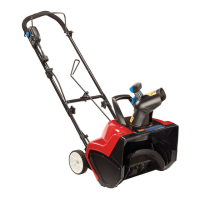
